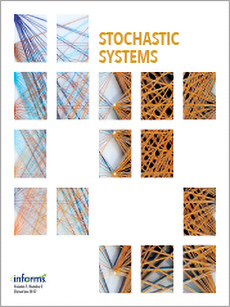Abstract
This paper provides an introduction to the Stein method framework in the context of steady-state diffusion approximations. The framework consists of three components: the Poisson equation and gradient bounds, generator coupling, and moment bounds. Working in the setting of the Erlang-A and Erlang-C models, we prove that both Wasserstein and Kolmogorov distances between the stationary distribution of a normalized customer count process, and that of an appropriately defined diffusion process decrease at a rate of $1/\sqrt{R}$, where $R$ is the offered load. Futhermore, these error bounds are universal, valid in any load condition from lightly loaded to heavily loaded.
Citation
Anton Braverman. J. G. Dai. Jiekun Feng. "Stein’s method for steady-state diffusion approximations: An introduction through the Erlang-A and Erlang-C models." Stoch. Syst. 6 (2) 301 - 366, 2016. https://doi.org/10.1214/15-SSY212
Information





